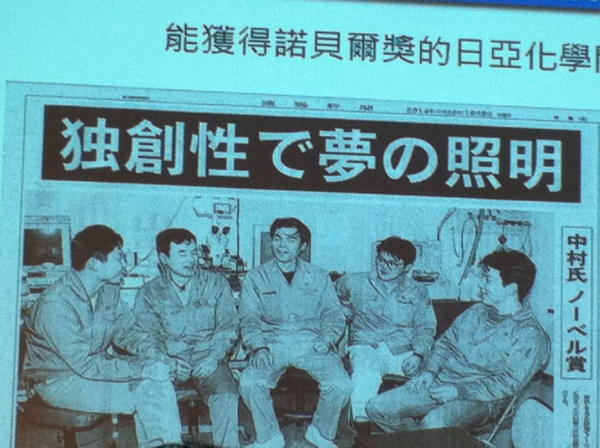After Shuji Nakamura was awarded the 2014 Nobel Prize in Physics last Tuesday, the lawsuit the Japanese scientist brought against former employer Nichia in 2001 over patent compensation received renewed media attention. The Japanese LED manufacturer insisted it compensated Nakamura fairly for his work at a press conference in Taipei on Thursday.
Nakamura, known as “the father of blue LED,” is credited as the first inventor to mass produce GaN blue LED cost effectively during the 1990s.
He is also one of the first researchers in Japan’s technology industry to sue a former employer for invention compensation, initially seeking as much as US $180 million in 2001. Nichia allegedly paid Nakamura a meager bonus of 20,000 Japanese yen (US $180) bonus for the GaN blue LED invention at the time, but has earned profits totaling 120 billion Japanese yen from the invention.
 |
|
Left to right: Masaki Mukaiyama, Special Consultant and spokesperson of Nichia Taiwan Corporation, Katsuki Akutagawa, the company’s Board Director and Chief Legal & IP Officer, Legal and Intellectual Property Division, Nichia, Hironori Takagi, General Manager, Intellectual Property Dep., Legal and Intellectual Property Division, Nichia.(LEDinside) |
Defending Nichia’s decision, Katsuki Akutagawa, the company’s board director and chief legal and IP officer, said Japanese corporations in the 1990s usually paid researchers 3,000, 5,000 or even 10,000 Japanese yen for patents. Nichia’s payment of 20,000 Japanese yen for Nakamura’s blue LED patent in the 1990s is considered generous and higher than the Japanese market average, he said.
 |
|
A newsclipping of Nobel Prize in Physics Laurete Shuji Nakamura (center) and fellow colleagues from Nichia GaN blue LED development team. (Nichia/LEDinside) |
Company officials said GaN blue LED represented the fruits of teamwork and was not the invention of a single man. “Nakamura acted as the project leader of the company’s blue GaN LED project,” said Masaki Mukaiyama, special consultant and spokesperson of Nichia Taiwan Corporation. “Nichia was unaware that Nakamura filed for patent ownership during the project’s early stages, which made him the patent holder.”
Nakamura’s patent ownership application was the decisive factor in the Tokyo District Court’s ruling that Nichia should compensate Nakamura with 20 billion Japanese Yen (US $180 million), which the LED manufacturer repeatedly appealed. Nichia and Nakamura later settled for a compensation amounting to US $8.1 million in 2005.
Nakamura’s lawsuit has changed Nichia’s payment scheme to some degree. Project leaders are paid the most, followed by co-leaders, while most employees generally receive an average salary rate, said Mukaiyama. The company’s current policies also continue to follow regulations as listed under Article 35 of the Japan Patent Law, which gives important rights for employee inventors, Akutagawa said.
(Author: Judy Lin, Chief Editor, LEDinsidehttp:// Editor: Matthew Fulco, Senior Editor, LEDinside)
(Editor's Note: A revised version of this article has been posted at 7:00 PM on Oct. 16, 2014.)












